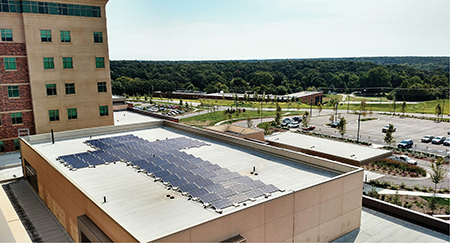BY: JOHN FARNEN, CHC

Solar panels on the roof of Mercy Hospital Joplin in Missouri.
You expect to see crosses in a Catholic health care facility. You will see them every where in Mercy buildings, from the windowpanes to the walls. But a unique cross composed of 100 solar panels at Mercy Hospital Joplin in Missouri is helping to reduce impact on the environment while serving as a reminder that caring for the Earth is an important part of caring for each other.
Mercy began the task of building the new facility after an EF-5 tornado in May 2011 destroyed the Joplin hospital. While it was an opportunity no one wanted, we embraced it and pledged to harden the new building against future storms while also conserving natural resources.
The sustainability efforts began before crews turned a single scoop of dirt. We studied water runoff from the property and then designed detention areas to filter water and ensure we did not have an impact on glades downstream. We also identified more than 400 trees on the property that could be dug up, maintained and then replanted on site after construction was complete.
Once excavation began, we hit those rocks that make the Missouri Ozarks famous. Crews recycled them as part of our building's foundation.
The building design called for energy-efficient windows that would take advantage of natural daylight yet keep out heat and cold. Motion sensors in offices automatically turn out lights and reduce heating and cooling when no one is around. Our parking lots have LED lights and solar sensors. Once the sun is bright enough, the lights turn off automatically. We estimate we have cut our energy usage in half in the parking lots alone.
It takes a lot of power to heat and cool an 890,000-square-foot building, so we had considerable potential for energy conservation in that area. We installed reflective roofs to reduce the heat load, and the heating, ventilation and air conditioning units feature a heat recovery wheel that captures warmth usually lost in units' air exhaust. On the flip side, for air that needs to be cooled even in winter, the system bypasses the electric chillers to lower the temperature naturally. For the air-handling units, we chose efficient and customizable "FANWALL" technology, which uses a wall of smaller fans instead of one large fan. It saves us about $240,000 each year in operating costs compared to traditional systems.
During the building's finish work, we took care to choose paint and adhesive products that had low levels of volatile organic compounds, or VOCs. This meant fewer fumes for construction workers as well as for those who would eventually occupy the building. Even the carpeting was low-VOC and certified as "green label plus." Other flooring, like the steps leading to the chapel, was both deeply symbolic and recycled, for some of it contains broken stained glass from the destroyed hospital's chapel. The glass not only enhances the floor's appearance, it also reminds us all that we walk in the footsteps of those who have served before. The new chapel wall features the Stations of the Cross salvaged from the old hospital.
About 60 percent of the new Mercy property is green space. Nature provides its own healing and soothing, and a walking trail encourages patients, visitors and staff to try to get outside for exercise and fresh air. The cancer center has its own dedicated garden, and patients can receive their infusions outside, if they wish. What's more, the 100,000 plantings on Mercy's campus not only are beautiful, they are native species and therefore will require less water and chemical fertilizers.
Here's more on that solar cross: We deliberately placed it on a lower roof so it would be visible to co-workers, patients and visitors. The 25.5-kilowatt system will save about $100,000 in energy costs over the life of the panels, but more importantly, the cross is a reminder of everything we did to bring our patients the most advanced, environmentally friendly and storm-hardened facility possible. Wherever we could make a smart, sustainable decision, we did.
Building the Joplin hospital taught us a lot about what's possible. Moving forward, Mercy's planning, design and construction group has formed a team to look at what we're currently doing for sustainability and what we should be doing on all projects. The team will study new technologies and energy-savings opportunities so we continually reduce our impact on the environment.
The Sisters of Mercy have taught us that all creation is God's gift, and we are responsible for caring for the Earth. Our Mercy values call us to be good stewards of our resources, and we intend to do just that.
JOHN FARNEN is vice president, Mercy planning, design and construction, Chesterfield, Missouri.